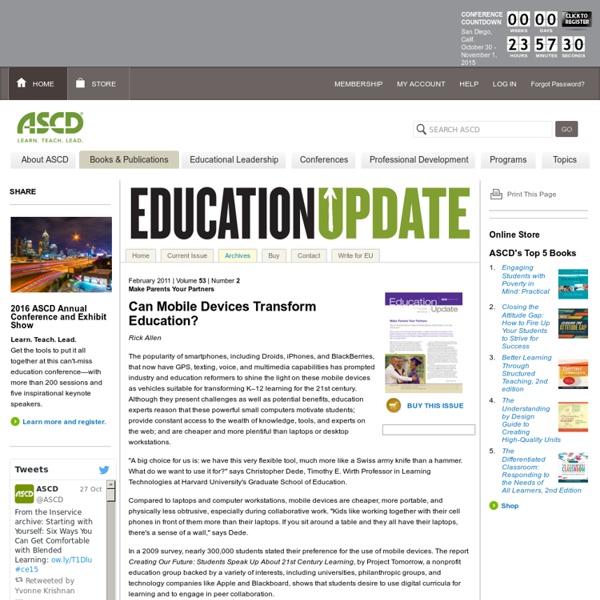Using Smartphones in the Classroom
By Edward Graham Found in: Advice and Support Ken Halla knows a thing or two about using technology in the classroom.
Exploring Students' Mobile Learning Practices in Higher Education
Key Takeaways A university-wide survey on students' mobile learning practices showed that ownership of mobile devices is high among students and that tablets are the most popular devices for academic purposes. The survey also found that mobile learning typically occurs outside the classroom, with only limited guidance from instructors. To improve mobile learning effectiveness, students and instructors need help adopting more effective learning and teaching practices across content areas. Baiyun Chen and Aimee deNoyelles are instructional designers at the University of Central Florida.
Mobile Learning Technologies for 21st Century Classrooms
By Jonathan Wylie The mobile revolution is here. More and more schools are moving toward mobile learning in the classroom as a way to take advantage of a new wave of electronic devices that offer portability and ease of use on a budget. Netbooks, iPads, cell phones, iPods, e-readers and even PDAs are increasingly becoming the tools of choice for today's educators, and it is easy to see why. Mobile learning technologies offer teachers-and students-a more flexible approach to learning. Computer labs are great, but do your students use technology in the classroom, in the school garden, in the study hall, in the gym, and on field trips?
Defining, Discussing and Evaluating Mobile Learning: The moving finger writes and having writ . . . .
John Traxler University of Wolverhampton, UK Abstract Since the start of the current millennium, experience and expertise in the development and delivery of mobile learning have blossomed and a community of practice has evolved that is distinct from the established communities of 'tethered' e-Learning. This community is currently visible mainly through dedicated international conference series, of which MLEARN is the most prestigious, rather than through any dedicated journals. So far, these forms of development and delivery have focussed on short-term small-scale pilots and trials in the developed countries of Europe, North America, and the Pacific Rim, and there is a taxonomy emerging from these pilots and trials that suggests tacit and pragmatic conceptualisations of mobile learning. Such a base would provide the starting point for evaluation methodologies grounded in the unique attributes of mobile learning.
Do mobile devices in the classroom really improve learning outcomes?
Mobile devices as teaching tools are becoming a more and more common part of the American education experience in classrooms, from preschool through graduate school. A recent Pew Research Center survey found that 58% of U.S. teachers own smartphones — 10 percentage points higher than the national average for adults. Those teachers are building that tech-savviness into their lesson plans, too, by embracing bring-your-own-device policies and leading the push for an iPad for every student. In 2013, an estimated 25% of U.S. schools had BYOD policies in place and it’s reasonable to assume those numbers have risen in the past two years. What do these mobile devices really add, though?



